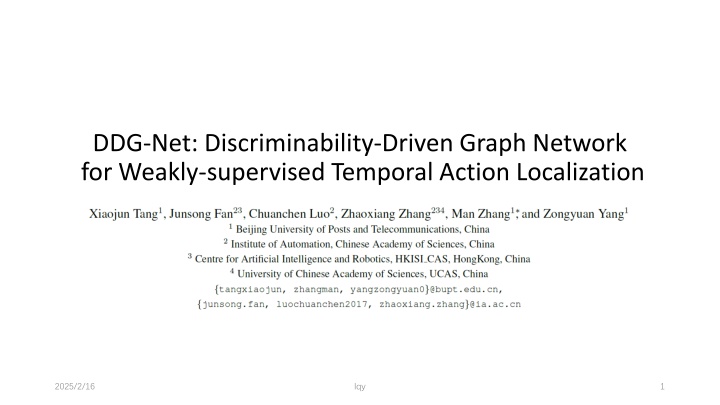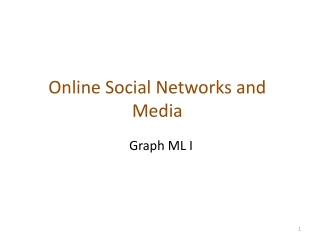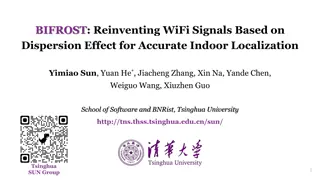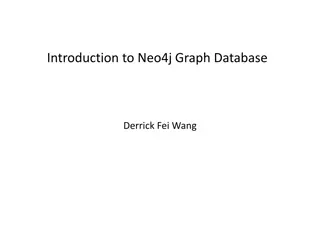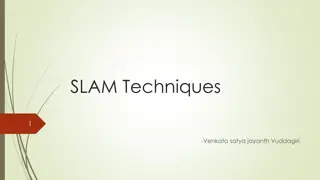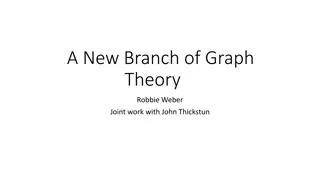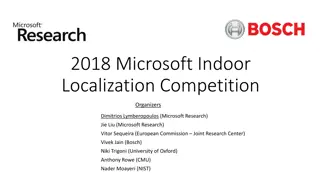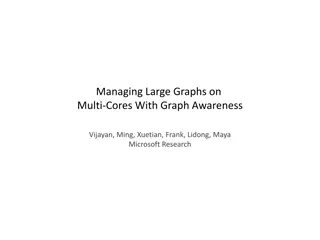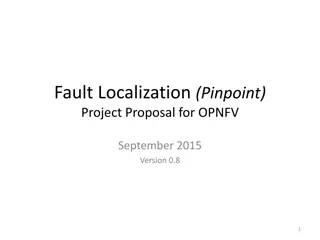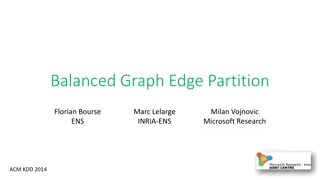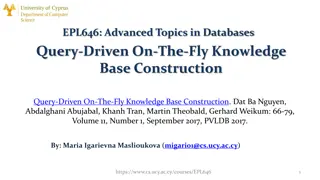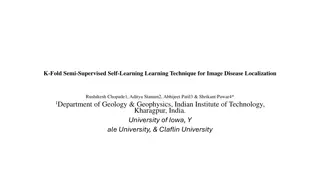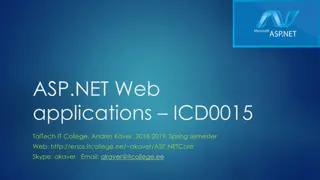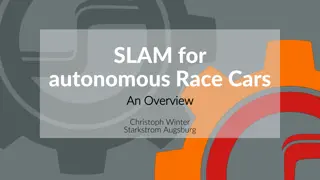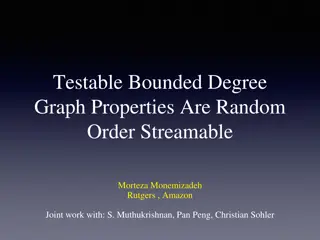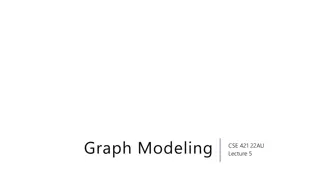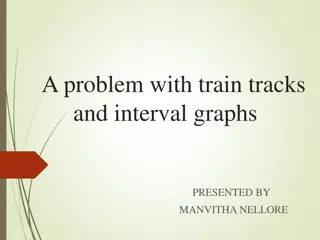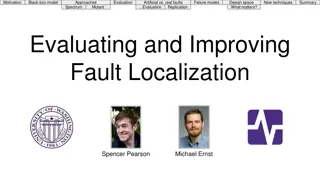Discriminability-Driven Graph Network for Action Localization
DDG-Net is a graph network designed for weakly-supervised temporal action localization, focusing on enhancing feature consistency and discriminability to improve action detection accuracy. The network explicitly models ambiguous snippets, preventing assimilation of features and driving the generation of discriminative representations.
Download Presentation

Please find below an Image/Link to download the presentation.
The content on the website is provided AS IS for your information and personal use only. It may not be sold, licensed, or shared on other websites without obtaining consent from the author.If you encounter any issues during the download, it is possible that the publisher has removed the file from their server.
You are allowed to download the files provided on this website for personal or commercial use, subject to the condition that they are used lawfully. All files are the property of their respective owners.
The content on the website is provided AS IS for your information and personal use only. It may not be sold, licensed, or shared on other websites without obtaining consent from the author.
E N D
Presentation Transcript
DDG-Net: Discriminability-Driven Graph Network for Weakly-supervised Temporal Action Localization 2025/2/16 lqy 1
Background WTAL: Weakly-supervised temporal action localization Large-scale datasets a pretrained network in other datasets to extract features Not suitable! Feature enhancement model temporal relationship between snippets HOWEVER - ambiguous snippets deliver contradictory information Reduce the discriminability of linked snippets 2025/2/16 lqy 2
Introduction Discriminability-Driven Graph Network (DDG-Net) 2025/2/16 lqy 3
Introduction Discriminability-Driven Graph Network (DDG-Net) Explicitly models ambiguous snippets and discriminative snippets Feature consistency loss Prevent the assimilation of features Drive the graph convolution network to generate discriminative representations 2025/2/16 lqy 4
Problem Formulation Given: an untrimmed video corresponding multi-hot action category label Goal a set of action instances related confidence score start and end timestamps of the corresponding action instance predicted action category 2025/2/16 lqy 6
Pipeline Baseline: DELU - cross-modal consensus module Divide an untrimmed video into ? non-overlapping 16-frame snippets RGB features and optical flow features by pretrained networks ? , Attention module to generate action attention weights Fuse two attention sequences Feature fusion module and Classifier to generate classification activation sequence (CAS) Suppressed CAS Train objective function 2025/2/16 lqy 7
Framework 2025/2/16 lqy 8
Graph Formulation ?? ?? ?? 2025/2/16 lqy 9
Graph Generation No supervision to snippet-level categories Consider the action weights of snippets as the judgment basis Edge weights: feature similarity 2025/2/16 lqy 10
Graph Generation No supervision to snippet-level categories Consider the action weights of snippets as the judgment basis Edge weights: feature similarity Ambiguous graph: masked partly 2025/2/16 lqy 11
Graph Generation Exploit complementary information of discriminative snippets Abandon confusing information from ambiguous snippets Discriminative information is delivered to relevant snippets while the ambiguous is never spread out Note: fusion of cross-modal adjacency matrixes and preventing the propagation of ambiguous information is vital 2025/2/16 lqy 12
Graph Generation No supervision to snippet-level categories Consider the action weights of snippets as the judgment basis Edge weights: feature similarity Ambiguous graph: masked partly 2025/2/16 lqy 13
Graph Inference 2025/2/16 lqy 14
Graph Inference Action graph and background graph: graph average and graph convolution are directly operated to obtain aggregated features following residual connection Graph average Graph convolution network (GCN) output of the l-th layer Activation function LeakyReLU Aggregated features Enhanced features 2025/2/16 lqy 15
Graph Inference Ambiguous graph Graph average Graph convolution network (GCN): difficult on training : partition of which only contain ambiguous columns and action rows a diagonal matrix GCN only learns to transform discriminative snippet features Ambiguous snippet representations benefit from the enhanced features via graph inference 2025/2/16 lqy 16
Feature Consistency Loss GCN prefers to transform all snippet-level features close to action characteristics for the classification task Drives the model to pursue classification performance, resulting in poor localization with chaotic features Hope: The most discriminative representations remain unchanged through DDG- Net because they can be recognized easily --- Hard! Punish the distance between graph average features and graph convolution features to realize the same function 2025/2/16 lqy 17
Experiments 2025/2/16 lqy 18
Experiments 2025/2/16 lqy 19
Ablation Study Effects of components The performance has a sharp decline of 10.3% because the GCN prefers to generate features attached to action for classification tasks, which is harmful to localization tasks 2025/2/16 lqy 20
Ablation Study Analysis of insight 2025/2/16 lqy 21
Recall: Graph Generation No supervision to snippet-level categories Consider the action weights of snippets as the judgment basis Edge weights: feature similarity Ambiguous graph: masked partly 2025/2/16 lqy 22
Qualitative results 2025/2/16 lqy 23
Bad Case The action snippets are pre-classified as pseudo-background, which suppresses their attention weights Performance of pre-classification is essential 2025/2/16 lqy 24
Conclusion A novel graph network for effectively enhancing the discriminability of snippet- level representations Feature Consistency Loss Comments Simple but valid A common but undiscovered question 2025/2/16 lqy 25
Writing (Column) Abstract Introduction Related work Base Model Method Experiments Conclusion 0.5 1.5 1 1 3 3 0.3 2025/2/16 lqy 26
Writing Method 3 Index 0.3 Graph Formulation 0.3 Graph Generation 1 Graph Inference 0.8 Feature Consistency Loss 0.5 Train Objective (Loss function) 3 lines Experiments 3 Experimental Setup 0.6 Datasets 0.3 Evaluation Metrics 3 lines Implement Details 0.2 Comparisons with SOTA Methods - 1 Ablation Study 1.5 Visualization Results 0.5 Conclusion 0.3 Introduction 1.5 Background of TAL and WTAL Intro of WTAL and problem Related work and disadvantages Our work Contributions Related Work - 1 WTAL 0.6 Graph-based WTAL 0.4 Base Model 1 Problem Formulation 0.2 Pipeline 0.8 2025/2/16 lqy 27
THANKS 2025/2/16 lqy 28
Weakly-supervised temporal action localization (WTAL) is a practical yet challenging task. Due to large-scale datasets, most existing methods use a network pretrained in other datasets to extract features, which are not suitable enough for WTAL. To address this problem, researchers design several modules for feature enhancement, which improve the performance of the localization module, especially modeling the temporal relationship between snippets. However, all of them omit that ambiguous snippets deliver contradictory information, which would reduce the discriminability of linked snippets. Considering this phenomenon, we propose Discriminability-Driven Graph Network (DDG-Net), which explicitly models ambiguous snippets and discriminative snippets with well-designed connections, preventing the transmission of ambiguous information and enhancing the discriminability of snippet-level representations. Additionally, we propose feature consistency loss to prevent the assimilation of features and drive the graph convolution network to generate more discriminative representations. Extensive experiments on THUMOS14 and ActivityNet1.2 benchmarks demonstrate the effectiveness of DDG-Net, establishing new state-of-the-art results on both datasets. Source code is available at https://github.com/XiaojunTang22/ICCV2023-DDGNet. WTAL 2025/2/16 lqy 29
Weakly-supervised temporal action localization (WTAL) is a practical yet challenging task. Due to large-scale datasets, most existing methods use a network pretrained in other datasets to extract features, which are not suitable enough for WTAL. To address this problem, researchers design several modules for feature enhancement, which improve the performance of the localization module, especially modeling the temporal relationship between snippets. However, all of them omit that ambiguous snippets deliver contradictory information, which would reduce the discriminability of linked snippets. Considering this phenomenon, we propose Discriminability-Driven Graph Network (DDG-Net), which explicitly models ambiguous snippets and discriminative snippets with well-designed connections, preventing the transmission of ambiguous information and enhancing the discriminability of snippet-level representations. Additionally, we propose feature consistency loss to prevent the assimilation of features and drive the graph convolution network to generate more discriminative representations. Extensive experiments on THUMOS14 and ActivityNet1.2 benchmarks demonstrate the effectiveness of DDG-Net, establishing new state-of-the-art results on both datasets. Source code is available at https://github.com/XiaojunTang22/ICCV2023-DDGNet. WTAL Problem 2025/2/16 lqy 30
Weakly-supervised temporal action localization (WTAL) is a practical yet challenging task. Due to large-scale datasets, most existing methods use a network pretrained in other datasets to extract features, which are not suitable enough for WTAL. To address this problem, researchers design several modules for feature enhancement, which improve the performance of the localization module, especially modeling the temporal relationship between snippets. However, all of them omit that ambiguous snippets deliver contradictory information, which would reduce the discriminability of linked snippets. Considering this phenomenon, we propose Discriminability-Driven Graph Network (DDG-Net), which explicitly models ambiguous snippets and discriminative snippets with well-designed connections, preventing the transmission of ambiguous information and enhancing the discriminability of snippet-level representations. Additionally, we propose feature consistency loss to prevent the assimilation of features and drive the graph convolution network to generate more discriminative representations. Extensive experiments on THUMOS14 and ActivityNet1.2 benchmarks demonstrate the effectiveness of DDG-Net, establishing new state-of-the-art results on both datasets. Source code is available at https://github.com/XiaojunTang22/ICCV2023-DDGNet. WTAL Problem Related Wrok 2025/2/16 lqy 31
Weakly-supervised temporal action localization (WTAL) is a practical yet challenging task. Due to large-scale datasets, most existing methods use a network pretrained in other datasets to extract features, which are not suitable enough for WTAL. To address this problem, researchers design several modules for feature enhancement, which improve the performance of the localization module, especially modeling the temporal relationship between snippets. However, all of them omit that ambiguous snippets deliver contradictory information, which would reduce the discriminability of linked snippets. Considering this phenomenon, we propose Discriminability-Driven Graph Network (DDG-Net), which explicitly models ambiguous snippets and discriminative snippets with well-designed connections, preventing the transmission of ambiguous information and enhancing the discriminability of snippet-level representations. Additionally, we propose feature consistency loss to prevent the assimilation of features and drive the graph convolution network to generate more discriminative representations. Extensive experiments on THUMOS14 and ActivityNet1.2 benchmarks demonstrate the effectiveness of DDG-Net, establishing new state-of-the-art results on both datasets. Source code is available at https://github.com/XiaojunTang22/ICCV2023-DDGNet. WTAL Problem Related Wrok Disadvantages 2025/2/16 lqy 32
Weakly-supervised temporal action localization (WTAL) is a practical yet challenging task. Due to large-scale datasets, most existing methods use a network pretrained in other datasets to extract features, which are not suitable enough for WTAL. To address this problem, researchers design several modules for feature enhancement, which improve the performance of the localization module, especially modeling the temporal relationship between snippets. However, all of them omit that ambiguous snippets deliver contradictory information, which would reduce the discriminability of linked snippets. Considering this phenomenon, we propose Discriminability-Driven Graph Network (DDG-Net), which explicitly models ambiguous snippets and discriminative snippets with well-designed connections, preventing the transmission of ambiguous information and enhancing the discriminability of snippet-level representations. Additionally, we propose feature consistency loss to prevent the assimilation of features and drive the graph convolution network to generate more discriminative representations. Extensive experiments on THUMOS14 and ActivityNet1.2 benchmarks demonstrate the effectiveness of DDG-Net, establishing new state-of-the-art results on both datasets. Source code is available at https://github.com/XiaojunTang22/ICCV2023-DDGNet. WTAL Problem Related Wrok Disadvantages Our work Contribution 1 2025/2/16 lqy 33
Weakly-supervised temporal action localization (WTAL) is a practical yet challenging task. Due to large-scale datasets, most existing methods use a network pretrained in other datasets to extract features, which are not suitable enough for WTAL. To address this problem, researchers design several modules for feature enhancement, which improve the performance of the localization module, especially modeling the temporal relationship between snippets. However, all of them omit that ambiguous snippets deliver contradictory information, which would reduce the discriminability of linked snippets. Considering this phenomenon, we propose Discriminability-Driven Graph Network (DDG-Net), which explicitly models ambiguous snippets and discriminative snippets with well-designed connections, preventing the transmission of ambiguous information and enhancing the discriminability of snippet-level representations. Additionally, we propose feature consistency loss to prevent the assimilation of features and drive the graph convolution network to generate more discriminative representations. Extensive experiments on THUMOS14 and ActivityNet1.2 benchmarks demonstrate the effectiveness of DDG-Net, establishing new state-of-the-art results on both datasets. Source code is available at https://github.com/XiaojunTang22/ICCV2023-DDGNet. WTAL Problem Related Wrok Disadvantages Our work Contribution 1 Contribution 2 2025/2/16 lqy 34
Weakly-supervised temporal action localization (WTAL) is a practical yet challenging task. Due to large-scale datasets, most existing methods use a network pretrained in other datasets to extract features, which are not suitable enough for WTAL. To address this problem, researchers design several modules for feature enhancement, which improve the performance of the localization module, especially modeling the temporal relationship between snippets. However, all of them omit that ambiguous snippets deliver contradictory information, which would reduce the discriminability of linked snippets. Considering this phenomenon, we propose Discriminability-Driven Graph Network (DDG-Net), which explicitly models ambiguous snippets and discriminative snippets with well-designed connections, preventing the transmission of ambiguous information and enhancing the discriminability of snippet-level representations. Additionally, we propose feature consistency loss to prevent the assimilation of features and drive the graph convolution network to generate more discriminative representations. Extensive experiments on THUMOS14 and ActivityNet1.2 benchmarks demonstrate the effectiveness of DDG-Net, establishing new state-of-the-art results on both datasets. Source code is available at https://github.com/XiaojunTang22/ICCV2023-DDGNet. WTAL Problem Related Wrok Disadvantages Our work Contribution 1 Contribution 2 Experiments 2025/2/16 lqy 35
Weakly-supervised temporal action localization (WTAL) is a practical yet challenging task. Due to large-scale datasets, most existing methods use a network pretrained in other datasets to extract features, which are not suitable enough for WTAL. To address this problem, researchers design several modules for feature enhancement, which improve the performance of the localization module, especially modeling the temporal relationship between snippets. However, all of them omit that ambiguous snippets deliver contradictory information, which would reduce the discriminability of linked snippets. Considering this phenomenon, we propose Discriminability-Driven Graph Network (DDG-Net), which explicitly models ambiguous snippets and discriminative snippets with well-designed connections, preventing the transmission of ambiguous information and enhancing the discriminability of snippet-level representations. Additionally, we propose feature consistency loss to prevent the assimilation of features and drive the graph convolution network to generate more discriminative representations. Extensive experiments on THUMOS14 and ActivityNet1.2 benchmarks demonstrate the effectiveness of DDG-Net, establishing new state-of-the-art results on both datasets. Source code is available at https://github.com/XiaojunTang22/ICCV2023-DDGNet. WTAL Problem Related Wrok Disadvantages Our work Contribution 1 Contribution 2 Experiments 2025/2/16 lqy 36
2025/2/16 lqy 37
